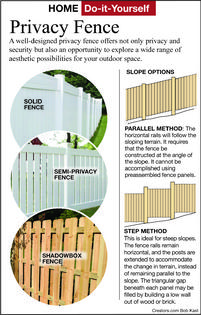Here's How: Build a New Fence for Privacy
Dear James: I live in a house on a sloping lot and want to add a privacy fence around the backyard. How should I construct it so it looks good down the sloping side? -- Diane K.
Dear Diane: You have several options for privacy fence designs and construction methods depending upon the level of privacy you want and your budget. For a do-it-yourself project, most of the design will require you to dig postholes for the tall support posts. It is hard work, and the posts are heavy.
Do some careful planning and layout work before you run out to the home center and start buying materials. Always contact your local zoning office to check on the allowable fence heights, setback from the lot line, designs and materials. There have been many fences built that are later torn out because they violate the zoning and codes.
Next, in order to keep the peace, talk with your neighbors about what you have planned. Even though it is your decision to make, talking with them is the courteous thing to do. If you are allowed to put the fence on the lot line, they may even offer to help pay for the materials. If so, make sure to put in writing who is responsible for the maintenance.
There are basically three types of privacy fencing that you can easily build yourself. A solid fence will give you complete privacy. The vertical pickets are attached very close together so it is very difficult to see between them.
Another option is a semi-privacy fence with a small space between the pickets. This may provide enough privacy for your needs, and it will allow some air flow through it. Since there are open areas, less wood is used, and the material costs may be lower.
The third design option is a shadowbox fence. On this design, the pickets are spaced apart but alternated on either side of the fence to give complete privacy with air flow. Your neighbors may also like this better because both sides of the fence look identical and attractive.
Armed with the above knowledge, go into your backyard and mark the locations of the corners of the fence with stakes. Drive a nail in the stakes and stretch layout strings between them to establish the line of the fence.
Since your lot slopes, you have two options for following the slope: parallel method and step method. In the parallel method, the top and bottom fence rails follow the slope of the ground. This requires that you attach each vertical picket individually to the top and bottom horizontal rails.
Your best bet is probably to use the step method and preassembled fencing panels. Each complete panel is attached to the fence posts so that the top is level. Each successive panel is stepped down on the post to follow the slope. This leaves a gap between the ground and the lower end of each panel. The height of the gap depends on the degree of the slope.
Select your preassembled panels, and carefully measure the length of each one. Mark each panel with a number. The lengths of each panel will determine the spacing of the 4" x 4" posts. Drive locator stakes, touching the string, in the ground at the post locations.
Once the postholes are dug, place the pressure-treated posts in them. Use a level on the posts to make sure that they are vertical. Use 2" x 4" bracing pieces to hold the posts in place. Pour in the concrete and mound it up a little against the post. When set after two days, nail on the preassembled panels.
========
Send your questions to Here's How, 6906 Royalgreen Dr., Cincinnati, Ohio, 45244 or visit www.dulley.com. To find out more about James Dulley and read features by other Creators Syndicate writers and cartoonists, visit the Creators Syndicate website at www.creators.com.
Copyright 2024 Creators Syndicate Inc.






























Comments